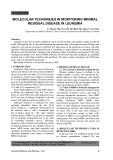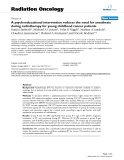
Journal of Medicine and Pharmacy - No.5 5
OVERVIEW
- Corresponding author: Le Thanh Nha Uyen, email: leuyen301@gmail.com
- Received: 15/5/2014 * Revised: 14/6/2014 * Accepted: 25/6/2014
MOLECULAR TECHNIQUES IN MONITORING MINIMAL
RESIDUAL DISEASE IN LEUKEMIA
Le Thanh Nha Uyen, Ha Thi Minh Thi, Nguyen Viet Nhan
Department of Medical Genetics, Hue University of Medicine and Pharmacy, Vietnam
Summary
Leukemia is the most common childhood cancer in both Vietnam and another country around the
world. Although the rate of successful treatment has increased due to the improvements of therapy and
supportive care, the rate of relapse is still high. The main reason is the persistence of cancer cells after
treatment. Detecting minimal residual disease is considered as “gold standard” in evaluating treatment
efficiency, selecting alternative therapies, and predicting relapse in leukemic management. In the past,
cytological techniques were used for MRD detection, but now the molecular techniques has gradually
replaced due to their high sensitivity and specificity. The most common techniques are PCR-based
assays and next generation sequencing.
Key words: Leukemia, cytological techniques, MRD
1. INTRODUCTION
Leukemia, which refers to cancers of the bone
marrow and blood, is the most common childhood
cancer. It accounts for about 31% of all cancers
in children in which acute leukemia constitutes
97 % of all childhood leukemia. The most common
types are acute lymphoblastic leukemia (ALL) and
acute myeloid leukemia (AML) which account for
75 % and 25 %, respectively [11].
About 3000 children in US and 5000 children
in Europe are diagnosed with ALL each year.
There are about 500 newly AML diagnosed cases
in US per year. In Vietnam, leukemia is also the
cancer with highest incident in children [11].
Although treatment in leukemia has been
gradually intensified during the last 30-40
years, leading to a significant improvement of
the outcome, there is still a remarkable high
rate of relapse, about 20 - 25%. Since minimal
residual disease (MRD) has played an important
role in leukemic management due to its value
in evaluating treatment success, following,
prognosis, early detection and predicting relapse
in leukemia patients [4] [6], methods which can
detect MRD earlier with high sensitivity and
specificity are preferred. Here, we introduce some
molecular techniques used widely in detection
MRD in leukemia.
2. MINIMAL RESIDUAL DISEASE
2.1. The concept of minimal residual disease
Minimal residual disease is defined as the
smallest number of cancer cells that persist in a
patient during or after treatment, even though
clinical and microscopic examinations confirmed
complete remission (CR) and the patient show no
signs and symptoms of disease [6][9].
2.2. Value of MRD in leukemic management
MRD provides an important feedback about
conventional treatment success and help in
selecting therapeutic alternatives. Also, MRD
is useful in following patient, and in predicting
relapse. Moreover, MRD studies have
demonstrated prognostic value when measured
before or after allogeneic haematopoietic cell
transplantation. Because this minimal number
of cancer cells is the main cause leading to
relapse or recurrence sooner or later, early
detection of MRD is very important in leukemic
management. The earlier MRD can be detected,
the better long-term outcome the patient can
obtain [4][6][10].
3. MOLECULAR TECHNIQUES USED IN
DETECTION MRD
In the past, CR was confirmed merely based
on clinical examinations (clinical CR) and
DOI: 10.34071/jmp.2014.1e.1






















